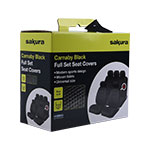
Consumer expectations on the recyclability of packaging has never been higher, with words and phrases such as ‘biodegradable’, ‘sustainable’ and ‘low carbon footprint’ moving from the vocal fringes into the mainstream.
That’s why Saxon, distribution experts for over 20 leading brands including Little Trees, The AA, Stoplock and Sakura, know they have an important part to play in getting their extensive portfolio of over 6,000 products to consumers in the most eco-friendly way.
Traditionally, the way that producers have boxed and bagged their products has been treated as a mere means to an end. As long as the packaging looked smart and merchandised the product in an effective way, the physical make-up of the box, potentially including combinations of recyclable and non-recyclable plastics and paper, would rarely come in to question.
Clair Seymour, Commercial and Product Manager for Saxon, was sensing the need for change, driven in part by conversations with several large UK retailers: “One thing that kept coming up regularly in feedback was the need to deliver sustainable packaging to an ever-expecting consumer, and many of these retailers were already undertaking their own programme of improvements. Keen to work with suppliers who would help them achieve their targets there was a drive to ensure that we were on the same page to ensure our products weren’t de-listed”.
It was a timely challenge as Clair had already been looking at the way Saxon had been packaging their top-selling products, joining forces with the On-Pack Recycling Label (OPRL) scheme, an organisation with the primary aim of encouraging customers to recycle correctly through simple and consistent on-pack imagery. Now side-by-side with other heavyweight members such as Shell, Tesco and Unilever, Saxon have begun introducing these clear recycling messages to an ever-increasing number of products.
Armed with a low-waste strategy in mind and the OPRL imagery, Clair kicked off a full review of their current packaging designs, beginning with their top selling Sakura car seat covers. Housed in a thick non-recyclable PVC outer with carded inserts, Clair observed: “it made no sense. As the seat covers were a buy-to-use product with all packaging immediately discarded and destined for landfill, we started to ask ourselves “what packaging is the customer going to keep for storage and what is the customer going to throw away?””.
Switching the PVC outer for easily recycled cardboard has seen a 100% reduction in plastic waste on the product, equivalent to more than 6 tonnes per year, a great start to the other improvements now filtering through Saxon’s range.
Initiatives such as switching PVC tray inserts for pulp material, switching PVC to low-density polyethylene (LDPE) and phasing out laminated cardboard means that both businesses and end consumers will gradually notice that they are throwing less away. And where they do need to dispose of packaging, they will be increasingly confident that it is easily recyclable thanks to the clear guidance from the OPRL imagery.
With new Government legislation on waste materials set to come in to play in April 2022, more and more businesses will need to follow Saxon’s lead and understand the impact that their packaging has on the environment. Introducing penalties for not meeting a minimal threshold of 30% recycled content will be a key driver to promoting compliance, even for those who realise that the correct packaging for the environment may not actually equate to a cheaper option.
“Switching malleable PVC for sturdy cardboard actually means you get a slightly smaller number of units on a pallet which can all add up over time” notes Clair. “But the need for the changes are much bigger than the impact on the P&L, they’re right for the consumer, for our landfill sites, and our long-term sustainable waste strategy”.
October 9, 2020
Design by Saxon Brands